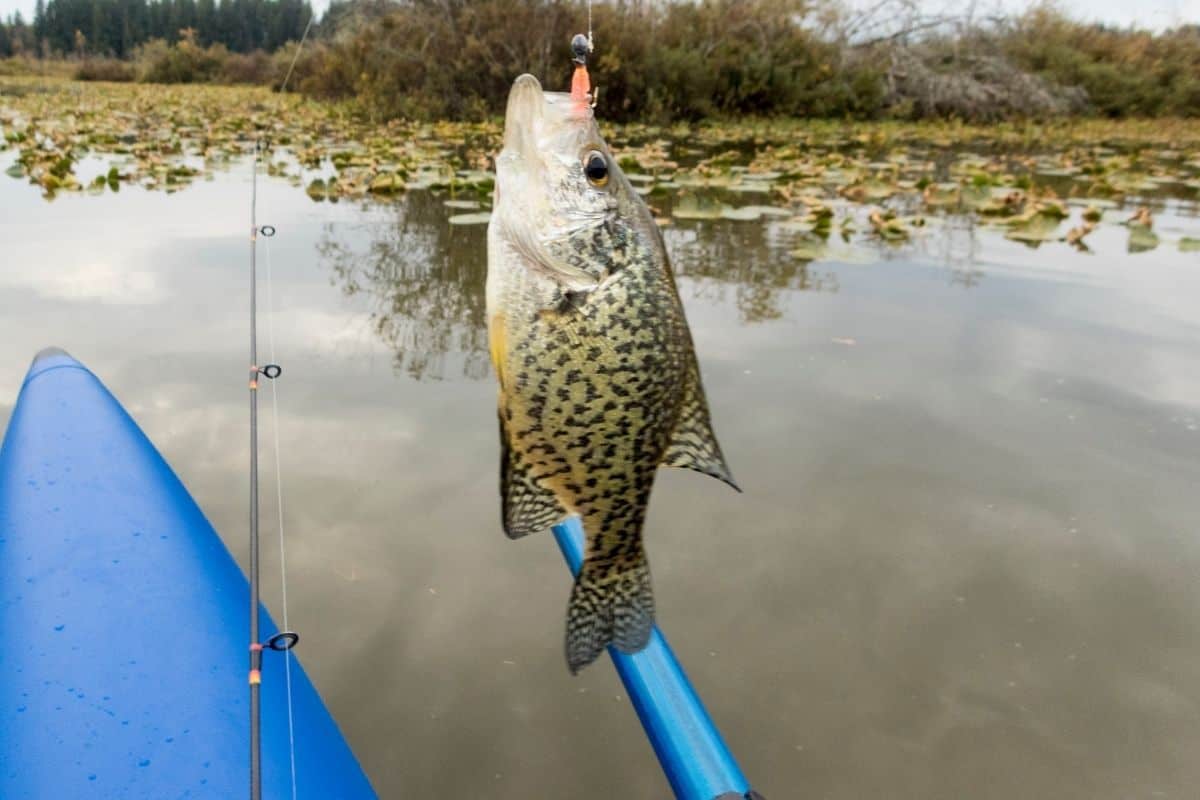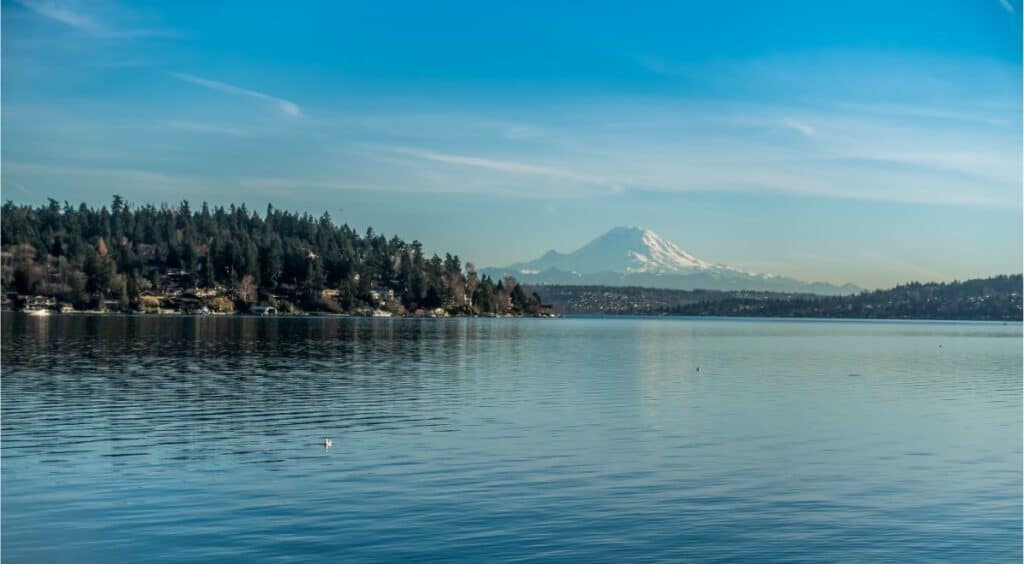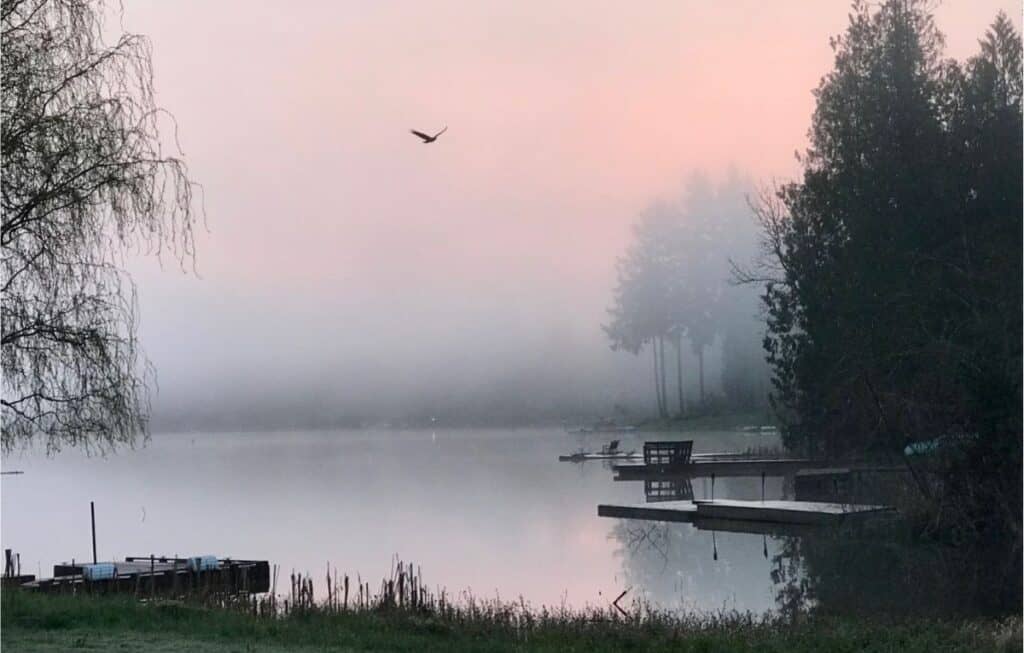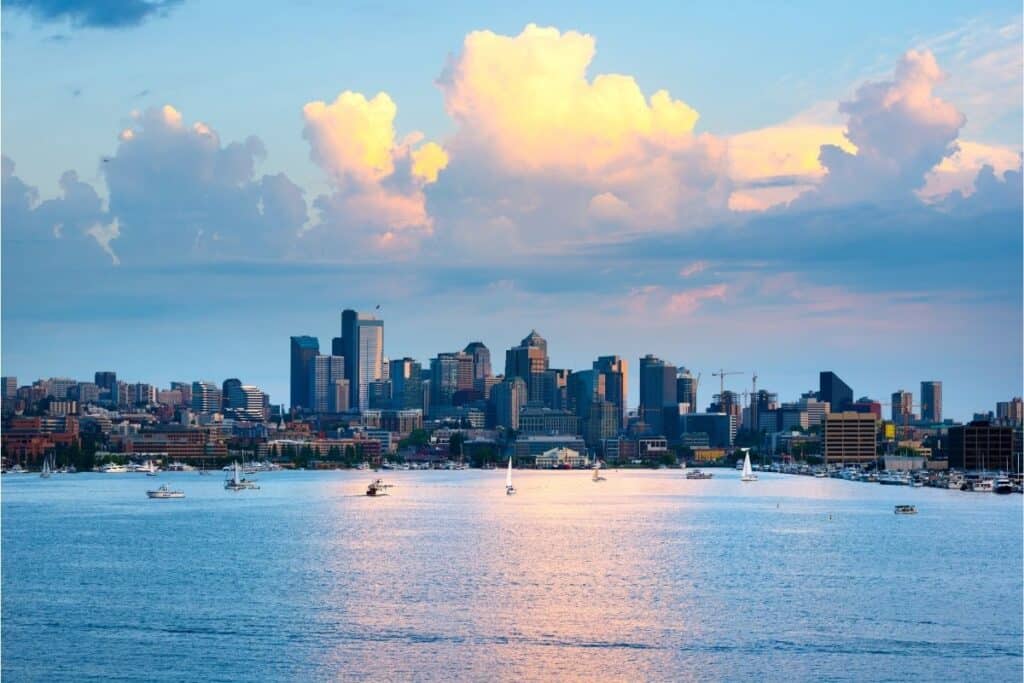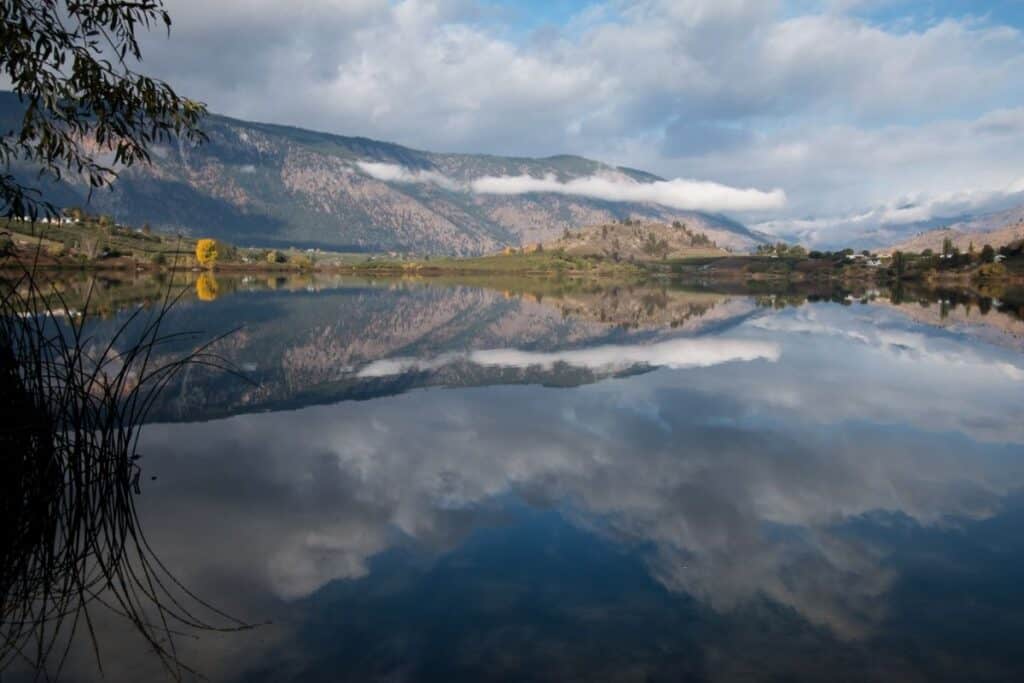Crappie have a way of inspiring a devoted following.
They’re neither the largest game fish in Washington nor the most plentiful, but they’re undeniably fun to catch.
They’re also handsome fish, hard fighters on light tackle, and highly prized as table fare.
If you’re looking for the best place to catch crappies across the state of Washington, you have a lot of options.
These fish are native to the eastern and midwestern U.S. but were introduced to Washington in the 1890s. Today, they are fairly widespread throughout the Pacific Northwest.
Two species of crappie inhabit Washington waters: black crappie and white crappie. Black crappie are more common, and favor clearer waters, while white crappie thrive in muddier conditions.
White crappie are lighter in body color and have markings resembling vertical bars, while black crappie are darker and have blotchy markings arranged seemingly at random.
While they have those differences in appearance, which can be subtle at times, the tactics used to catch the two species also are essentially the same.
Washington Crappie Fishing Tips
Any lure that resembles a small baitfish is likely to draw a strike from crappie.
Soft plastic jigs like curlytail grubs and tube jigs are favorite lures, but a variety of small spinners, spoons and crankbaits can also be effective.
Live minnows, a favorite crappie bait in many locations, aren’t legal to use in Washington’s freshwater fishing spots.
Often the brightest colors, like white, hot pink and chartreuse, tend to be the best.
Crappies have a way of changing their minds from one day to the next, so it’s always a good idea to hit the water with small plastic jigs in a wide range of colors.
Some anglers troll for crappies, while others cast and retrieve jigs or drift bait under a bobber.
Overall, you’ll want to keep your bait at about the depth the crappie are holding, which changes seasonally.
Springtime is the best season for crappie fishing in Washington.
In many Washington lakes, crappies leave winter haunts in about March and start moving into pre-spawn patterns. As the waters warm into the mid-50s, crappies work their way into shallower water.
Most lakes experience a lull in crappie fishing during the hot summer months.
Although fewer anglers chase them than during spring, the crappie action may pick up again in fall as waters cool down and crappie can more comfortably hunt in the shallows. Plus, they are eagerly fattening up for winter, when their metabolisms slow way down.
Crappies are notoriously picky when it comes to temperature.
In early spring, a part of a lake that’s just one or two degrees warmer may hold schools of crappies while an otherwise identical spot across the lake may be devoid of fish only because it’s ever-so-slightly cooler.
Early in the spring, crappie congregate around any available cover as they transition toward the shallows. Submerged timber, docks, fallen trees, brush and even rock piles can hold fish.
As more aquatic vegetation grows, crappie often transition to weed beds, eventually spawning in May or June before they return to deeper, cooler water.
Washington has no statewide limit on crappie, but certain lakes have a 9-inch, 10-fish limit in place to help improve crappie populations and grow larger fish.
Here are a dozen of our favorite crappie fishing spots in Washington.
Silver Lake
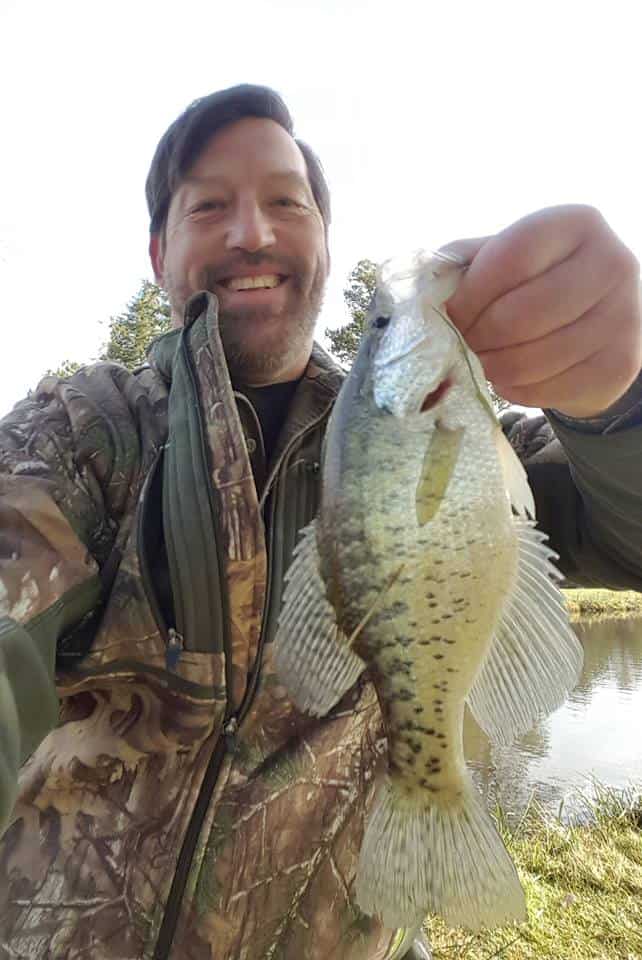
Cowlitz County’s Silver Lake—not to be confused with lakes of the same name elsewhere in the state—is high in the running for the title of Washington’s best crappie lake.
Silver Lake is better known for numbers of crappie than for size, but there aren’t many places where you can more easily fill your livewell with medium-sized fish for the table.
Although it’s a fairly large lake at 1,424 acres, Silver Lake is also quite shallow, without much water deeper than about 10 feet.
That means it warms up fast in springtime, and is one of the first lakes in the state to see a solid early season crappie bite.
The other side of that coin is that the water gets pretty hot in summer, and crappie fishing tends to bottom out in July and August before rebounding as the weather cools in fall.
In March through May, crappie are easy to find in and around the channels at the north end of the lake, around Treehouse Island, and close to cover along weed-lined shores throughout the lake’s shallows. Timber Point on the southern shore is also a prime spot.
A lot of local anglers troll for crappies at Silver Lake (both white and black crappie are present) while others drift bait under bobbers or cast jigs to brush and weeds. A 9-inch minimum and a 10-fish limit are in place here.
Several sections of the lakeshore are highly developed, with an abundance of boat docks that hold crappies in spring and fall.
Try slowly cruising along the shore with your trolling motor, casting to docks until you get a bite. Once you’ve caught one crappie, it’s a safe bet that there are more close by.
Shore fishing access is fairly limited on Silver Lake. Most of the shoreline is either privately owned or inaccessible wetlands.
However, there are some spots along the highway and some private spots with modest fee access on the eastern end of the lake, and fishing here can be excellent in the fall months.
The best boating option is to launch at the Silver Lake Boat Ramp just off Kerr Road at the north end of the lake.
In addition to crappie, Silver Lake is also one of the best largemouth bass lakes in Washington, and also offers good fishing for other warm water species including bluegill, bullhead and yellow perch. A modest number of trout are stocked as well.
More: Fishing at Silver Lake in Cowlitz County
Moses Lake
Encompassing 6,727 acres in the central part of the state, Moses Lake offers some of the best crappie fishing opportunities in Washington, although the fishing does tend to be cyclical.
Some years are better than others, but there’s almost always a chance to find some good-sized crappies here.
Fed by Crab Creek (a tributary of the Columbia River), Moses Lake was once a small, shallow natural lake. But it was transformed into a much larger reservoir with the construction of a dam in the early 20th century.
Over the years the lake has been stocked with a variety of game fish, crappie included. Moses Lake is best known these days for its walleye fishing.
Like most Washington lakes, the prime crappie seasons on Moses Lake are April through May and September through October.
White and chartreuse jigs including tubes and split-tail grubs can be great for crappie when the bite is on.
Early in the spring it’s common to find crappies holding tight to docks and submerged timber.
Parker Horn and Pelican Horn—two large bays off the east side of the lake—offer prime crappie spawning grounds.
Moses Lake is a long, meandering reservoir with an abundance of public access.
Blue Heron Park is a great place to start. This public park on the western shore of Moses Lake offers a boat ramp, fishing dock and ample open shoreline.
The park is located just off the I-90 bridge that spans the lake. The rocky shoreline on either side of the bridge is also a popular area for shore anglers.
The lake narrows significantly in this spot, creating a discernible current that attracts a lot of fish to the area.
A little farther south along the western shore of Moses Lake, the two outlet spillways are also popular local fishing holes for crappie, walleye and a variety of other fish species. Parking is available, and the spillways can be easily fished from shore.
More: Moses Lake Fishing
Lake Washington
When John W. Smart caught his 4.5-pound state record black crappie from Lake Washington in 1956, he probably couldn’t have guessed that his record would still stand more than 60 years later.
But while that record may remain untouched, Lake Washington remains one of the best places in the state to catch slab crappies.
Sprawling across a vast 21,933 acres, Lake Washington is the largest lake in Western Washington, and its location right between Seattle and Bellevue makes it something of an urban playground for boaters and anglers.
It’s one of the best fishing spots in the state for a variety of species, but the lake is so vast and offers so many opportunities that crappie go relatively unnoticed, at least by most anglers.
But the fact remains that it’s one of Washington’s best crappie lakes for numbers as well as size.
There’s solid crappie fishing from April well into summer on Lake Washington, but the best time to be on the lake is May, when crappies are in full-on spawning mode. The trick is locating them amidst so much water.
Lake Washington has more than 20 public fishing piers and numerous parks and boat ramps. A lot of local crappie aficionados focus on the southern end of the lake from the I-90 bridge down to the Cedar River inlet.
Gene Coulon Park, located at the south end of the lake, is a perennial favorite among anglers. The park includes a boat ramp, fishing piers and ample open shoreline, and there’s a lot of prime crappie habitat nearby.
Bailey Peninsula and the western shore of Mercer Island are also areas where crappies can reliably be found in springtime. There’s a decent amount of brush and vegetation in these areas, along with an abundance of boat docks.
More: Lake Washington Fishing
Potholes Reservoir
A large reservoir spanning more than 14,200 acres in the Columbia Basin, Potholes Reservoir is one of Washington’s great walleye and largemouth and smallmouth bass fisheries. It also happens to be an outstanding crappie lake.
In springtime, the Crab Creek area offers some of the best crappie opportunities. Toward the north end of Potholes Reservoir, there’s a maze of tiny islands and channels where Crab Creek feeds the lake.
You’ll find a ton of prime crappie habitat here, including weed beds and brush that are favorite spawning sites.
The Crab Creek Public Access offers shore fishing and launching for small craft. Many anglers also choose to launch farther south at Potholes State Park.
A little later in the year, there’s also some great crappie action at the south end of the lake in the Lind Coulee area. Crappies often congregate around deeper cover here, and trolling is the most efficient way to locate schools of them.
The Washington Department of Fish & Wildlife operates several public access sites on Lind Coulee, including the Sampsons Pit Access Site and Lind Coulee Bridge Access Site.
The shoreline of Potholes Reservoir is less developed than most major Washington lakes, so docks aren’t a major factor in the crappie fishing here.
Even so, the fishing pier and docks at MarDon Resort at the southern end of the lake are always worth a try if you’re visiting the resort.
More: Potholes Reservoir Fishing
Honorable Mentions
Dozens of lakes across the state of Washington offer opportunities to catch crappies.
While these honorable mentions may not be quite the sure bets that the aforementioned lakes are, they each offer opportunities to hook up with your favorite panfish.
Bonnie Lake
Less than an hour from Spokane, Bonnie Lake is one of Eastern Washington’s great warm water fisheries, with an abundance of crappie, largemouth bass and yellow perch.
It’s also a strikingly beautiful lake, surrounded by rugged canyon walls and pine-studded hills.
Bonnie Lake is a long, narrow lake of about 327 acres, and it offers a lot of shoreline brush, rocks and fallen trees that can harbor crappies. Some real giants have been caught here.
You can catch crappies throughout the spring months by casting toward shoreline cover.
The marshy area at the south end of the lake around the Rock Creek outlet is often one of the best spots.
All the typical crappie jigs seem to work well here, but the best colors may vary from day to day so be prepared to swap out lures until you find the day’s top choice.
The lake is a bit hard to get to, located on the border of Spokane County and Whitman County. (Not to be confused with the city of Bonney Lake near Tacoma.)
Once you arrive, it also requires some walking. Boats larger than what you can carry aren’t recommended.
The only access site is off Belsby Road, and is only open to the public through the kindness of private landowners, so please be courteous in return to keep the privilege.
Tanwax Lake
About 40 minutes south of Tacoma, Tanwax Lake offers a solid crappie fishery during the spring months. Expect a lot of fish in the 9- to 10-inch range, with the occasional slab mixed in.
The 172-acre lake is easily accessible via the Department of Fish & Wildlife boat ramp at the south end of the lake, which provides public launch facilities as well as shore fishing access.
The docks at nearby Rainbow RV Resort are known to hold crappies in springtime, and many anglers fish around Camp Lakeview, up at the lake’s northern tip.
Tanwax Lake is a great kayak fishing lake thanks to its small size. Paddling around the shoreline and casting jigs toward weeds and docks is often productive for crappies. As lily pads start to develop, crappies often use them for cover as well.
WDFW stocks Tanwax Lake with rainbow trout every spring. Anglers armed with Trout Magnet jigs or other minnow-imitating lures are likely to catch a mixed bag of crappie and trout in April shortly after stocking.
More: Tanwax Lake Fishing
Lake Cassidy
Lake Cassidy’s reputation as a booming crappie lake isn’t quite what it was 10 years ago. But there’s no doubt that these fish are still present, and the cyclical nature of crappie fishing makes Cassidy Lake a great lake to keep an eye on.
Spanning 123 acres about 45 minute north of Seattle in Snohomish County, Cassidy Lake is easily accessible, with a WDFW boat ramp on the western shore and a small fishing pier on the eastern shore. It’s an ideal lake to fish from a canoe, kayak or float tube.
The recurring pattern at Cassidy Lake seems to be that crappies bite around dusk on late spring and summer evenings, and seemingly disappear throughout the rest of the day.
Around sundown, look for telltale dimples on the water that reveal crappies feeding on the surface.
Small jigs can get a lot of bites during this narrow window of time.
Suspending a jig under a float or using a cast-and-retrieve method can work equally well, provided you keep your bait high in the water column.
Lake Union
An urban lake in the heart of Seattle often overlooked by King County anglers, Lake Union is a highly underrated option when it comes to crappies.
Lake Union is connected to Lake Washington via channels and also is chock full of moored boats, and the fishing conditions here are generally similar, even though Union is much smaller at 1,030 acres.
Crappies in Lake Union start to wake up and start moving toward pre-spawn patterns as early as March, and often congregate around wooden dock pilings.
There are a ton of wooden docks along the west shore, many of which reach into 40-foot depths and provide an easy route for crappies to follow toward shallower spawning sites.
Weeds start emerging in April, and as they grow crappies will transition more to weed beds. If you can locate wooden docks with deep pilings and weeds nearby, you can catch crappies from that spot all spring.
Eloika Lake
About 45 minutes north of Spokane, Eloika Lake is a prime panfish lake where anglers often catch black crappie and yellow perch on back-to-back casts.
A 9-inch minimum size and 10-fish limit on crappie is in place here to help increase the average size of the fish.
As the spring spawn gets underway in April and into May, the backwaters and sloughs at either end of the lake are the best crappie fishing areas.
Trolling along the deep edge of shoreline weeds can also be effective in fall, and ice fishing is popular on Eloika Lake in winter.
The WDFW public access site near the southern end of the lake is the best option for launching a boat.
Shore fishing on Eloika Lake is somewhat limited, but Jerry’s Landing Resort does offer some access for guests.
More: Eloika Lake Fishing
Roses Lake
This 178-acre lake is part of a small cluster of lakes located just off the eastern shoulder of Lake Chelan, one of Washington’s largest and most well-known fishing lakes.
As a result, smaller Roses Lake tends to get overlooked.
That’s a shame, because there is a solid crappie population here, along with good numbers of channel catfish, yellow perch and largemouth bass.
But it seems most people ignore Roses Lake except for the brief window in April right after rainbow trout are stocked.
The boat launch, dock and parking area on the south side of the lake offers easy access, and you can often catch crappies right from the boat launch in spring and fall.
You might have to catch 10 small crappies to get one keeper, but numbers are usually high enough to keep the fishing fun.
Lake Kapowsin
Lake Kapowsin is a popular destination for Pierce County anglers, being just 45 minutes from the city.
Trout are stocked here every April, but it’s mainly a warm water fishery, with good populations of black crappie, largemouth bass, bluegill and perch.
There’s a lot of brush and logs on the bottom of Lake Kapowsin due to its former use by loggers to transport timber, and successful crappie anglers usually key in on woody cover.
The lake spans 490 acres, and much of its shoreline is lined with logjams and fallen trees, so there’s lots of crappie habitat.
April and May are prime months for crappie here.
Lake Kapowsin is a great kayaking lake, and there’s a WDFW launch on the north shore just off Oroville Road. There are also hiking trails that lead from the road down to the water for shore fishing.
More: Lake Kapowsin Fishing
Washington Resources
WDFW Fishing and Stocking Reports
WDFW Fishing Regulations
National Weather Service forecasts

